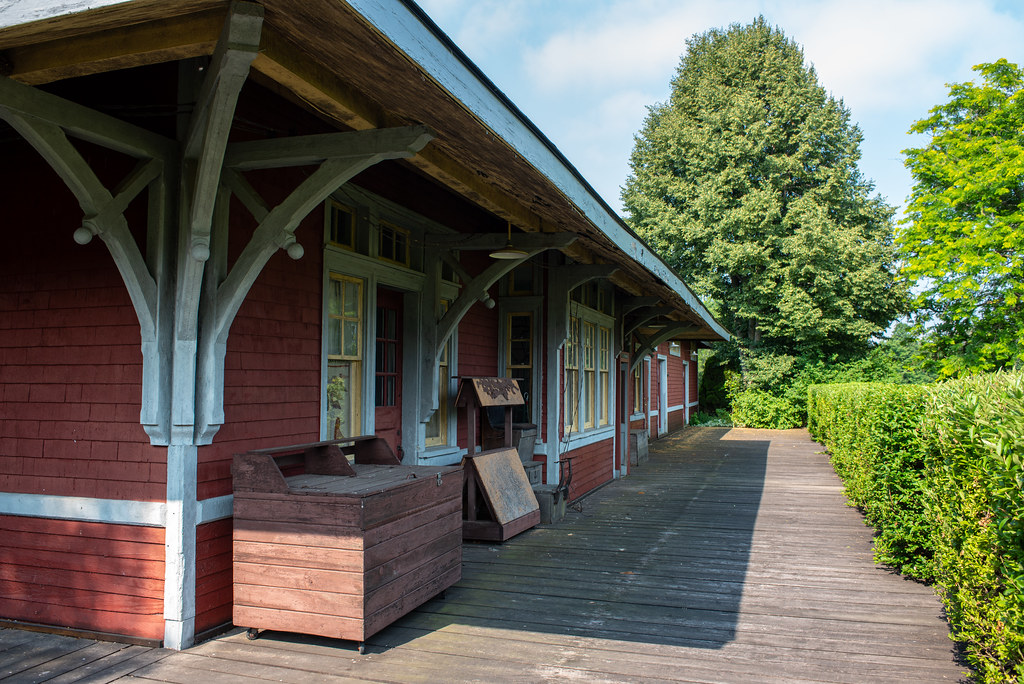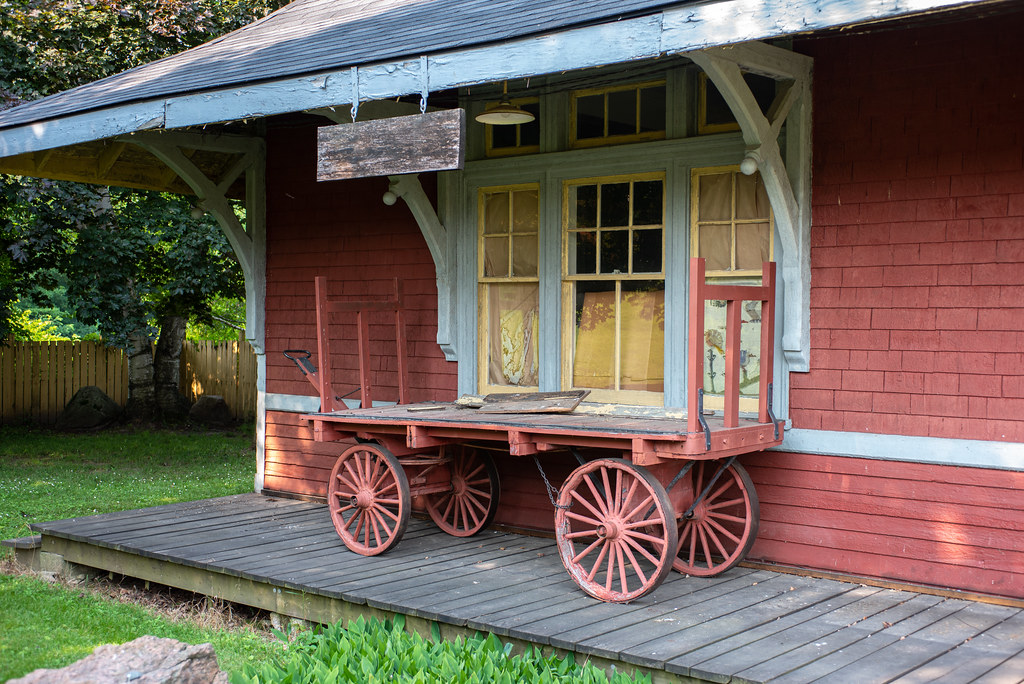Sitting in the shadow of the Old Mill Leather Store sits a red building; it looks shabby, with peeling paint and shingles. Still, it stands as one of the few surviving stations of the Canadian Pacific branch line that operated for only a short 82 years, bringing freight and passengers between Guelph and Goderich as a direct competitor to the Grand Trunk and later Canadian National lines.

Graflex Crown Graphic – Nikon Nikkor-W 1:5.6/180 – Ilford HP5+ @ ASA-200 – Pyrocat-HD (1+1+100) 9:00 @ 20C
The first railway to pass through Blyth came in 1876 with the Lake Huron & Brantford Railway; However, it would eventually fall to Grand Trunk. It offered little to the community until the 20th Century, the only railway operator in town. It wouldn’t be until 1907 that a second and far more efficient line arrived. It all started in Guelph, have thumbed their noses at Grand Trunk in 1884 by building the Guelph Junction Railway. The line connected the city to the Canadian Pacific Railway mainline at Campbellville. After completion, the city leased the line to Canadian Pacific. A new need arose as a second line to Goderich from Guelph. Again thanks to inaction by Grand Trunk, the city went to the Canadian Government to grant a charter to the Guelph & Goderich Railway and allowed Canadian Pacific to construct the line. Sadly Canadian Pacific would not act fast enough and surveyed three routes, all of which bypassed Blyth. The Federal Government granted the charter in 1903, and the city surveyed a new route and turned things over to Canadian Pacific, who agreed to the new route. Construction lasted from 1904 to 1907, with Canadian Pacific coming out with a 999-year lease, provided they did not cut any traffic on the Guelph Junction line.

Nikon D750 – AF-S Nikkor 28-70mm 1:2.8D
Nikon D750 – AF-S Nikkor 28-70mm 1:2.8D
At Blyth, most of the work fell to recently arrived Italian immigrants. But the star attraction that drew local onlookers was the heavy construction vehicles, a new inclusion in the construction of railways in the area. At Blyth, the railroad decided to open up a large freight yard with sheds and animal pens to support the local agricultural economy. This yard required a new ditch for the nearby creek to have enough land for the yard. Located by Bainton’s Old Mill on Westmoorland, Canadian Pacific constructed a passenger and operations station. The new station had larger footprints than other stations along the route, allowing for a larger freight room and an apartment for the station agent. The wooden station using board and batten techniques also had a single general waiting room, a ticket office, station agent office, telegraph operator bay and a yard operation office. All this in a single storey. The station followed the newly popular prairie style out of Chicago that gained popularity in commercial buildings. Canadian Pacific also constructed a bridge to carry their line over the Grand Trunk line. The first train arrived at the station on 8 July 1907, and the entire town turned out to see its arrival. Although the train carried only the staff to main the station and the yard and arrived at 10:30 pm, a local newspaper noted that little could be seen for lack of lights. The line’s primary use was freight, and the Blyth yard always had some activity. Although passenger service proved far more popular than Grand Trunk, with Canadian Pacific running four daily trains. They also dedicated newer rolling stock to the branch line. Freight trains, however, numbered over 100 cars in a single train. The Great Depression saw the reduction to a pair of dedicated passenger trains. The post-war era saw dedicated passenger trains cut completely. Instead, Canadian Pacific ran two daily mixed trains with passenger and freight cars; these mixed trains ceased in 1961. In the mid-century, the station received a repaint to the new standard railroad red.

Nikon D750 – AF-S Nikkor 28-70mm 1:2.8D
Nikon D750 – AF-S Nikkor 28-70mm 1:2.8D
Despite the cut of passenger service, the station remained necessary for the operation of the freight yard, but even those activities were starting to stagnate. By the early 1970s, the livestock pens had been removed, and service quickly started to wind down by the end of the decade. The Blyth station did see a passenger train when in 1977, Canadian Pacific ran an old steam locomotive excursion train past the station. By decades end, the station had been closed. When Canadian Pacific determined that the old station should be demolished, a local leather goods store, The Old Mill, expressed an interest in the historic station. In 1983 they arranged to purchase the surplus building and had it moved intact to their property outside the town proper on Highway 4. There they conducted a renovation and restoration into a storage and discount shop. The final train to depart from the Blyth yards took place in 1988. By 1989 both Canadian National and Canadian Pacific removed the rails through Blyth. Canadian Pacific going so far as to destroy the rail bridge completed in 1907. Today the old station remains in the shadow of the Old Mill Leather Store, looking worse for wear and used more for storage and shopping. The old bridge forms part of the Guelph to Goderich Rail Trail completed out of the old right-of-way. The local Lion’s Club building a wooden bridge connecting the two stone abutments of the former Canadian Pacific bridge, which remains a local landmark.